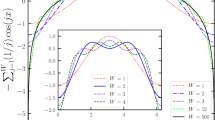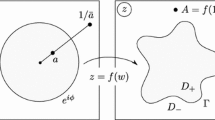Abstract
The evolution of the distribution function of a dynamical system governed by a general two-dimensional area-preserving iterative map is studied by the methods of nonequilibrium statistical mechanics. A closed, non-Markovian master equation determines the angle-averaged distribution function (the “density profile”). The complementary, angle-dependent part (“the fluctuations”) is expressed as a non-Markovian functional of the density profile. Whenever there exist two widely separated intrinsic time scales, the master equation can be markovianized, yielding an asymptotic kinetic equation. The general theory is applied to the standard map in the diffusive regime, i.e., for large stochasticity parameter and large scale length. The non-Markovian master equation can be written and solved analytically in this approximation. The two characteristic time scales are exhibited. This permits the thorough study of the evolution of the density profile, its tendency toward the Markovian approximation, and eventually toward a diffusive Gaussian packet. The evolution of the fluctuations is also described in detail. The various relaxation processes are governed asymptotically by a single diffusion coefficient, which is calculated analytically. This model appears as a testing bench for the study of kinetic equations. The various previous approaches to this problem are reviewed and critically discussed.
Similar content being viewed by others
REFERENCES
R. Balescu, Phys. Rev. E 58:951 (1998).
B. V. Chirikov, Phys. Reports 52:265 (1979).
A. J. Lichtenberg and M. A. Lieberman, Regular and Stochastic Motion(Springer, New York, 1983).
L. E. Reichl, The Transition to Chaos(Springer, New York, 1992).
A. Lasota and M. C. Mackey, Probabilistic Properties of Deterministic Systems(Cambridge University Press, Cambridge, 1985).
R. Balescu, Statistical Dynamics: Matter out of Equilibrium(Imperial College Press, London, 1997).
G. M. Zaslavsky and B. V. Chirikov, Usp. Fiz. Nauk 105:3 (1971).
A. B. Rechester and R. B. White, Phys. Rev. Lett. 44:1586 (1980).
A. B. Rechester, M. N. Rosenbluth, and R. W. White, Phys. Rev. A 23:2994 (1981).
R. H. Cohen and G. Rowlands, Phys. Fluids 24:2295 (1981).
J. D. Meiss, J. R. Cary, C. Grebogi, J. D. Crawford, A. N. Kaufman, and H. D. J. Abarbanel, Physica D 6:375 (1983).
M. A. Lieberman and A. J. Lichtenberg, Plasma Phys. 15:125 (1973).
H. D. J. Abarbanel and J. D. Crawford, Phys. Lett. A 82:378 (1981).
H. H. Hasegawa and W. C. Saphir, in: Aspects of Nonlinear Dynamics, I. Antoniou and F. Lambert, eds. (Springer, Berlin, 1991).
O. F. Bandtlow and P. V. Coveney, J. Phys. A: Math. Gen. 27:7939 (1994).
I. Prigogine and P. Résibois, Physica 27:629 (1961).
R. Zwanzig, in Lectures in Theoretical Physics, Vol. 3 (Wiley-Interscience, New York, 1961).
R. Balescu, Equilibrium and Nonequilibrium Statistical Mechanics(Wiley-Interscience, New York, 1975).
I. Prigogine, Nonequilibrium Statistical Mechanics(Wiley-Interscience, New York, 1963).
R. Balescu, Statistical Mechanics of Charged Particles(Wiley-Interscience, New York, 1963).
H. H. Hasegawa and W. C. Saphir, Phys. Rev. A46:7401 (1992).
G. Nicolis, Introduction to Nonlinear Science(Cambridge University Press, Cambridge, 1995).
N. G. van Kampen, Stochastic Processes in Physics and Chemistry(North Holland, Amsterdam, 1981).
C. W. Gardiner, Handbook of Stochastic Processes, 2nd edition (Springer, Berlin, 1997).
R. Tabet, D. Saifaoui, A. Dezairi, and A. Raouak, Eur. Phys. J. AP 4:329 (1998).
S. Benkadda, S. Kassibrakis, R. B. White, and G. M. Zaslavsky, Phys. Rev. E 55:4909 (1997).
R. B. White, S. Benkadda, S. Kassibrakis, and G. M. Zaslavsky, Chaos 8:757 (1998).
I. Dana and S. Fishman, Physica D 17:63 (1985).
I. Dana, Physica D 39:205 (1989).
C. F. F. Karney, A. B. Rechester, and R. B. White, Physica D 4:425 (1982).
C. F. F. Karney, Physica D 8:360 (1983).
J. D. Meiss and E. Ott, Phys. Rev. Lett. 55:2741 (1985); Physica D 20:387 (1986).
Y. H. Ichikawa, T. Kamimura, and T. Hatori, Physica D 29:247 (1987).
T. Horita, H. Hata, R. Ishizaki, and H. Mori, Prog. Theor. Phys. 83:1065 (1990).
R. Ishizaki, T. Horita, T. Kobayashi, and H. Mori, Prog. Theor. Phys. 85:1013 (1991).
J. Klafter, G. Zumofen, and M. F. Shlesinger, Fractals 1:389 (1993).
G. Zumofen and J. Klafter, Europhys. Letters 25:565 (1994).
H. D. J. Abarbanel, Physica D 4:89 (1981).
H. H. Hasegawa and D. J. Driebe, Phys. Rev. E 50:1781 (1994).
I. Prigogine, C. George, F. Henin, and L. Rosenfeld, Chemica Scripta 4:5 (1973).
B. Misra, I. Prigogine, and M. Courbage, Physica A 98:1 (1979).
T. Petrosky and I. Prigogine, Chaos, Solitons Fractals 7:441 (1995).
H. H. Hasegawa and W. C. Saphir, Phys. Lett. A 161:471, 476 (1992).
H. H. Hasegawa and W. C. Saphir, Phys. Lett. A 171:317 (1992).
D. J. Driebe, Fully Chaotic Maps and Broken Time Symmetry(Kluwer, Dordrecht, 1999).
D. Ruelle, Phys. Rev. Lett. 56:405 (1986).
P. Gaspard, Chaos, Scattering and Statistical Mechanics(Cambridge University Press, 1998).
N. G. van Kampen, Physica 21:949 (1955); 23:641 (1957).
K. M. Case, Ann. Phys. 7:349 (1959).
T. Y. Petrosky, in: Statistical Physics and Chaos in Fusion Plasmas, C. W. Horton, Jr. and L. E. Reichl, eds. (Wiley-Interscience, New York, 1984).
P. V. Coveney and A. K. Evans, J. Stat. Phys. 77:229 (1994).
A. K. Evans and P. V. Coveney, Proc. Roy. Soc. London 448:293 (1995).
A. K. Evans and P. V. Coveney, J. Phys. A: Math. Gen. 31:5887 (1998).
Author information
Authors and Affiliations
Rights and permissions
About this article
Cite this article
Balescu, R. Kinetic Theory of Area-Preserving Maps. Application to the Standard Map in the Diffusive Regime. Journal of Statistical Physics 98, 1169–1234 (2000). https://doi.org/10.1023/A:1018619829416
Issue Date:
DOI: https://doi.org/10.1023/A:1018619829416




